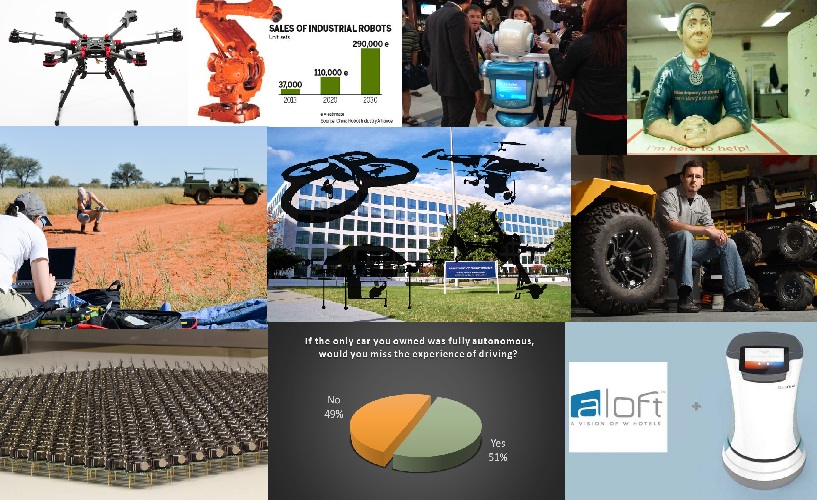
Robohub.org
Robohub Digest August 2014: Drone deliveries, record robot sales, job fears, butlers and more

A quick, hassle-free way to stay on top of robotics news from the past month, our monthly digest is released on the first Monday of every month.
Fighting for lift-off
As predicted in our July digest, this August once again saw a flurry of activity around drones and drone regulation.
In a bold move, Amazon, 3D Robotics, DJI (which just released their new Spreading Wings S900), Parrot and others came together to form a “Small UAV coalition” to speed up federal action on drone regulation. With their eye squarely on the consumer market, the new coalition has hired DC-based lobbying firm Akin Gump in an effort to smooth the way for civil drone development in the US; you can learn more about why the coalition members felt such a step was necessary here.
The following week, the Association for Unmanned Vehicle Systems International (AUVSI) wrote an open letter to the FAA in support of Amazon’s bid to test its PrimeAir drone delivery service, and just days later, Google revealed that it was also getting into the drone delivery game, having secretly developed their own platform in Australia for the past two years. Commercial drone advocates are hoping that the heft of these big players will spur US regulators into action.
In labs around the world, researchers are focusing on making drones safer and more efficient for these kinds of applications. At MIT, roboticists have been looking into allowing delivery drones to monitor their own health and, if necessary, reroute to a recharge station to avoid running out of fuel mid-mission. Similarly, a paper recently published by John Daly explored how UAVs might pair up with unmanned ground vehicles (UGVs) to extend the range of UAV delivery systems. Finally, students at the University of Leuven have developed VertiKUL, a new drone with two modes that can lift off like a helicopter, but fly like a plane.
Although it will be some time before these innovations make it to market, it’s clear that progress toward commercial drone systems is being made on all fronts. And this is great news for the many businesses and industries that stand to benefit from their widespread use. And not all benefits will be solely for commercial gain: as ecologist Lian Pin Koh explained this month, drones have the potential to be used as conservation tools. In Namibia for example, drones have just been used for nature conservation mapping, allowing scientists to map the vast area of Kuzikus Wildlife Reserve. Similarly, many believe drones could support humanitarian aid efforts. For instance, researchers from the University of North Texas are now developing a drone that expands the wifi range for zones hit by disasters.
And from the frontiers of research …
Of course robotics research is not all about drones, and this month saw developments in other exiting areas of robotics too. Roboticists in Harvard have produced a swarm of over 1000 robots that can self-assemble into arbitrary shapes without the need for an operator. Also at Harvard, graduate students have developed an Origami-inspired robot that can fold itself and start working without any intervention from a human controller. Scientists at the University of Houston in Texas are looking into developing mind-controlled robotic legs, and in France, a group of researchers at the Sorbonne have built a robot that can learn to walk again after breaking its leg.
More ups than downs for robot businesses
The sudden announcement of Unbounded Robotics’ shut down took many in the robotics community by surprise, especially given its star status as a Willow Garage spinoff. Despite this upset, robotics business is looking bright: the North American Robotics Industries Association announced that the first half of 2014 set a new record in robot sales, and Korea announced a $2.6 billion public-private investment in robotics by 2018, following various other countries and governments that have promised more funding for robotics over the past few months.
Jobbing robots
While businesses and industries are clearly excited by the potential of robotics, a report this month by the Pew Research Center asked robotics experts whether robots will create more jobs than they will take, highlighting the risks for blue-collar workers in particular.
Broadly speaking, there appear to be two camps: those who take the dystopian view, believing that mass unemployment will result as robots replace human workers; and those who see things more positively, arguing that robots will augment our work rather than replace us, and that they will be needed to maintain productivity in the face of a rapidly ageing workforce. A summary of some of the arguments used by both camps can be found in a series of videos about robots and jobs.
To be fair, the PEW report also emphasised some of the positive potential of AI and robotics in the workplace; however, since its publication it has been heavily scrutinized, namely by Erik Sofge in his blog Zero Moment. He argued that the report was nothing more than “speculative fiction” and that it fell prey to some of the most common myths about robotics. Erik’s article was welcomed by many who say that robotics and its impact on the economy is a complex matter that is far harder to predict than one might first believe.
At your service
Which camp is right about the future of robots and their impact on the economy remains to be seen. However, there can be no doubt that service robotics has made a giant leap over the past decade, and the latest industry to embrace a robotic workforce is the tourism industry. Starwood hotels have teamed up with Savioke and are now trialling robot butlers at the Aloft Cupertino hotel in Silicon Valley. Guests can now look forward to receiving room service from a new member of staff – a robotic butler called botlr. Similarly, at the Edmonton airport in Canada, travellers who are lost or need directions can now get help from a multi-lingual customer service robot called Furo. Furo can not only give you directions, but might even accompany you to where you have to go – just to make sure you find the right gate in time.
Demerit points, anyone?
The safety record of autonomous may not be as squeaky clean as has been previously suggested, as Quartz revealed that Google kept minor accidents of its vehicles secret. Although these accidents happened while the cars were disengaged (being driven by a human rather than in autonomous mode), these incidents may have serious implications for situations in which transition from autonomous to manual mode are necessary, for instance when the car enters an unmapped area. Further safety risks relating to cars already on the market today, such as Cadillac Escalades, Jeep Cherokees or Infiniti Q50s, were exposed this month as these vehicles may be at risk of hack-attacks.
Perhaps unsurprisingly in light of such reports, Robohub readers were split as to whether they would miss their good old manual cars. Adding to the discussion around autonomous driving, Brad Templeton wondered how cities and city transportation might change to take advantage of autonomous cars, and Patrick Lin asked whether adjustable ethics settings in self-driving vehicles would be a good idea.
Have heart, dear robot
This month Waterloo-based Clearpath Robotics made a public pledge that it will not develop lethal autonomous weapons, despite holding various military contracts. The move sets a precedent in corporate responsibility, disclosing the company’s stance on roboethics and supporting the Campaign to Stop Killer Robots.
And speaking of corporate responsibility, Slate magazine argued this month that if US federal law extends ‘legal personhood’ to corporations, it should do the same for robots as well.
Upcoming events in September to watch our for:
- Minesweepers: Towards a Landmine-Free World; September 1-3; Coimbra, Portugal
- IFA Consumer Electronic Show; September 5-10; Berlin, Germany
- IMTS 2014 – International Manufacturing Technology Show; September 8-13; Chicago, USA
- 2014 The Second Machine Age Conference (IDE / MIT); September 10-11; Cambridge, USA
- IROS 2014 – IEEE/RSJ International Conference on Intelligent Robots and Systems; September 14-18; Chicago, USA – Hope to see you there!!
- Spatial Cognition 2014; September 15-19; Bremen, Germany
- RE.WORK Technology Summit; September 18-19; London, UK
- World Maker Faire – New York; September 20-21; NYC, USA
- Robot Technology Exhibition (RTEX); September 28-30; Dubai, UAE
tags: Robohub Digest




